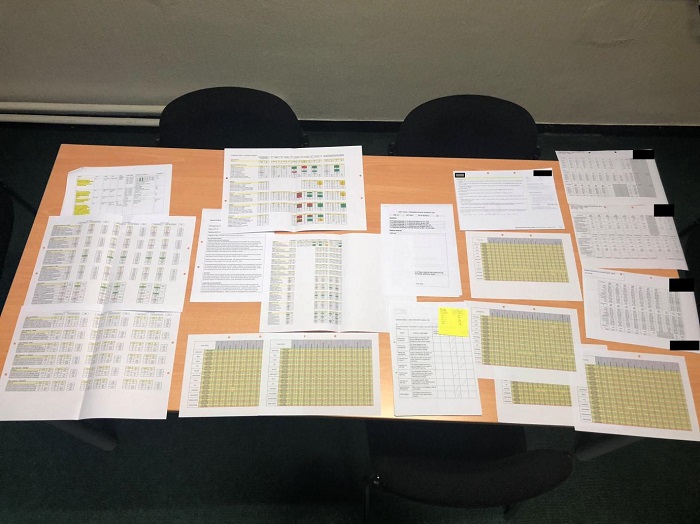The problem
A member of my close family recently completed a History degree at one of our top universities, with a well-deserved upper second class award. He has aspergers, and the level of student support was excellent.
His work over the three years of the course was largely completed on his laptop, on screen, online, and using a variety of “It’s like learning to drive in an F1 car and then being assessed on horseback.”software and hardware to complete research and assignments; not to mention communication and collaboration in his coursework. However, when it came to his end-of-year and end-of-course summative assessment, it was by a method from a bygone era: pen and paper, a technology he had not used for years.
This is the equivalent of learning to drive in a formula one car, and then being assessed riding horseback.
So the problem is that the design principles upon which our education and training system - including formative and summative assessments - is predicated on methods from a bygone age, and are now no longer fit for purpose in a digital world.
But why is education and training so slow to evolve when it comes to the use of technology for teaching, learning and assessment? We do not seem to have been so slow when it comes to gathering and analysing data for school improvement, if my latest Secondary school governors meeting is anything to go by...

Well this is also from the wise Professor Laurillard:
“The drivers of the education system - assessment, curriculum, inspection/quality requirements, funding flows, promotion criteria - have not changed in recognition of what technology offers, so nothing within it can change.”
And there is another part of the problem. The regulatory framework, the funding methodology, the audit and inspection regimes have cocooned the education and training system from the technological changes which have affected every other part of life.
The real potential of technology is not just to reduce teacher workload but to engage and empower learners...and transform feedback and assessment...#ascl2018 https://t.co/wlOTXCofec
— Bob Harrison (@BobHarrisonEdu) March 10, 2018
However, there are glimmers of light shining through. As well as being a judge for the Bett Awards and the Times Educational Supplement FE Awards for outstanding use of technology, “Robots are being used to teach and assess languages.”I have had the privilege to be a judge for the International e-Assessment Awards, and have been inspired by some of innovative and exciting developments in the pipeline. These have included the use of artificial intelligence and a robot to teach and assess languages, the use of video for the peer-assessment of clinical practice for paramedics, the paperless assessment of apprenticeships across a wide range of vocational areas, and the use of secure on and offline assessments in financial qualifications in Brazil and Mexico. These are just a small selection of the hundreds of examples across the cutting edge of edtech-enhanced assessment.
As a judge of the TES FE Awards for the outstanding use of technology for teaching learning and assessment, I was delighted the entry from Blackburn College was shortlisted. Peter Shukie, HE lecturer and Digital Innovation lead at the College’s University Centre, explained:
“The project responds to the need for developed approaches to assessment that recognise the world that students (and teachers / lecturers / researchers / academics) live in, and the skills and exposure that will benefit them. This includes both using technology to create, and using technology to develop networks in which they might gain additional exposure to their work, share ideas and gain valuable feedback and advice - while simultaneously learning how to write for other audiences, rather than a tutor marking their work.”
I’d recommend Peter’s blog on interactive essays, which you can read at: http://ucbcdigitalpioneers.blogspot.co.uk/2016/02/interactive-essays.html
So what is going on in schools?
Further, vocational, work-based and adult-oriented learning seems to be widening the DfE’s horizons when it comes to the use of technology for assessment. Plus, they now have a small-but-energetic team of civil servants beavering away behind the scenes, trying to nudge ministers and agencies to be a bit more innovative when it comes to assessing learning. Sadly, though, there seems to be a mental block.
Whilst sending text messages to remind students they have an exam or test may be a start, and recent ideas around the testing of timetables on a tablet are interesting. However, these are unlikely to be shortlisted in the Innovation category for the e-Assessment Awards. I suppose we must take these as small but encouraging signs of a step on the path to enlightenment?
More encouraging, however, are the great examples of innovation I have witnessed at hundreds of TeachMeets over the past few years. Here, teachers share with other teachers how they are using technology in formative and summative assessment, through a range of subjects.
One of my ETAG collaborators - and friend - is Professor Peter Twining, who co-chaired the assessment sub-group of ETAG, and has spent some time looking at the use of technology in the southern hemisphere. Here is a presentation he gave on the matter in 2015: http://www.btl.com/wp-content/uploads/2015/06/Peter-Twining-Speaking-at-BTL-30th-anniversary-2015.pdf
My 10 years as chief examiner for a large vocational assessment body taught me the three pillars of assessment are Relevance, Reliability and Validity. Whilst I can see two of the pillars, reliability and validity could possibly be met by traditional assessment practices. I am doubtful that many learners would find some of the current methods very relevant. It is time we had a ‘paradigm shift’ in the way we think about how technology can be used for assessment.
I began this article with Professor Laurillard, so it is only fitting I should give her the last word: "Using technology to improve education is not rocket science...it is much, much harder than that."
And here she is speaking at Abertay University about technology and learning:
More challenges and opportunities are approaching fast.... augmented and virtual reality (AR / VR), artificial intelligence (AI) and, of course, the use of robots in a mobile, wearable and cloud-based world. Some of the assessment practices currently used in education are not fit for purpose. We need a paradigm shift in the way the awarding bodies and regulatory authorities innovate with the use of technology to ensure reliable, valid and, most importantly, relevant assessments.
Want to receive cutting-edge insights from leading educators each week? Sign up to our Community Update and be part of the action!


















